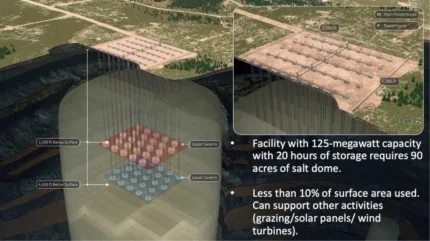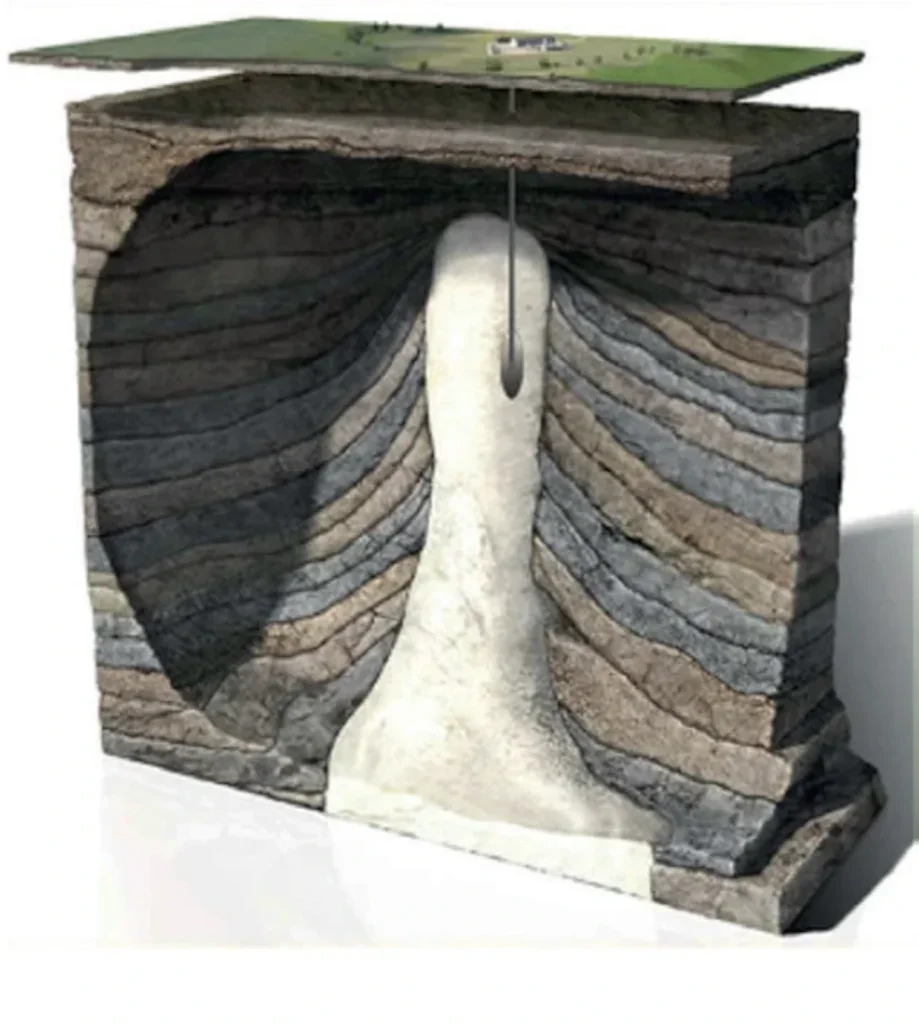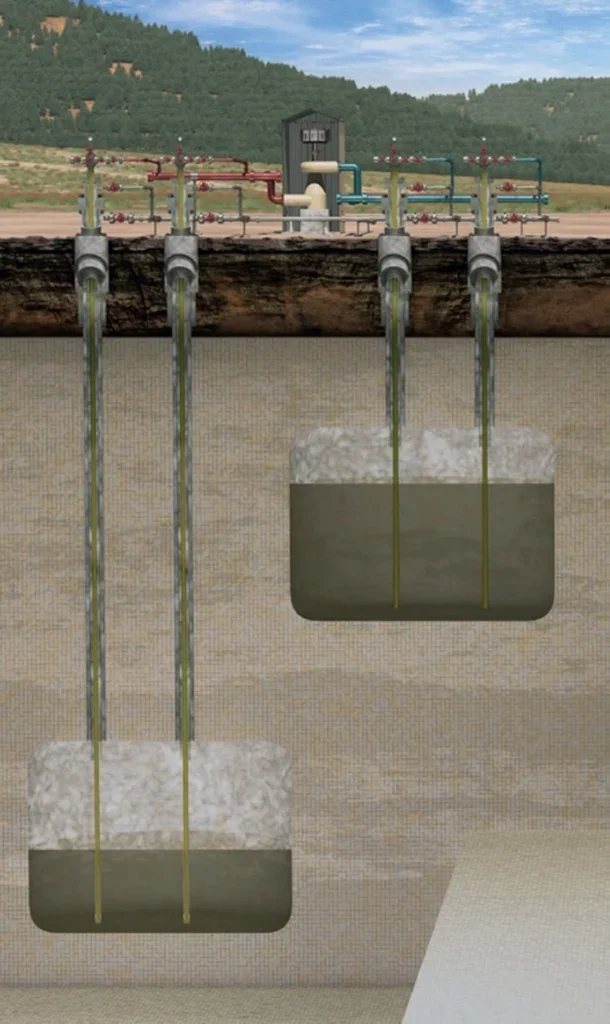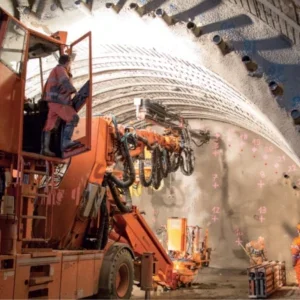
Looking at the increasing amount of solar and wind in some utility markets, especially across Texas, there was clearly a need for energy storage on the Gulf Coast. And this has been recognised by the United States’ Department of Energy (DOE) which formed the Energy Storage Grand Challenge to encourage long duration energy storage (LDES) development, provided grant funding, and encouraged developers to participate in the LDES Consortium they formed with the national laboratories. To date, however, none of these efforts have been successful at filling the requirements.
Cavern Energy Storage was formed over two years ago when I asked a basic question, “How do you provide LDES to Texas, Louisiana, and Mississippi?” I felt like the answer had to be something that would tailor understood technologies but deploy them in a way that was unique to the region. As it turns out the answer was under my feet all along.
Pumped storage hydropower requires large elevation difference between the water reservoirs to make it economical. A requirement that the flat terrain of the Gulf Coast in Texas, Louisiana, and Mississippi can’t supply. But while the Gulf Coast lacks mountains, it does have salt domes – large geological formations of salt that are thousands of feet wide and miles deep.
Since the 1940s, the DOE, oil companies, natural gas pipeline companies, as well as others have used salt domes to create underground storage caverns for oil, natural gas, hydrogen, and many other fluids. The Strategic Petroleum Reserve operated by the DOE is 60 salt dome caverns in four locations that can store over 700 million barrels of oil.
And salt domes can provide a lot of energy storage. Cavern Energy Storage estimates that there are 160 salt domes on accessible land in Texas, Louisiana, and Mississippi with over 40,000 unused acres that could be developed into 50GW of capacity with twenty hours of storage. This could easily supply the bulk of the LDES requirement for the over 25 million people that live in this region. There are also salt domes in Europe, the Middle East, and other areas of the world.
Underground pumped storage hydroelectric is the combination of these two proven technologies, pumped storage and salt dome caverns. Cavern Energy Storage has patented a construction method that allows for an economical way to build the energy storage that we will need in the future.
GOING UNDERGROUND
Underground pumped storage hydroelectric uses large wellbores drilled into the salt domes to two different elevations. Once the wellbores are in place, water is pumped down the interior casing and returns up the annulus of the wellbore as saturated salt brine. This is a process called solution mining by injecting water and removing the brine which dissolves the salt and forms the caverns. The brine is processed to remove the salt which can be sold as a commodity and then the water is returned to do more solution mining.

Once the caverns are formed, compressed air is added to create the space in the caverns to move the brine back and forth. The compressed air also raises the brine pressure in the interior casing so that the pump/turbine can sit on the surface.
The pump/turbine looks just like a conventional pumped storage one, but with saturated salt brine as the fluid rather than regular water. The brine is pumped from the lower cavern into the upper cavern to store energy. To recover the energy, the brine flows through a hydroelectric turbine – just as in regular pumped storage to generate electricity back to the grid. The compressed air freely flows between the caverns as brine is moved out of one and into the other.
There is a practical limit on how big you can make the caverns, so a single upper cavern and lower cavern form a 5MW pair with 20 hours of storage. But the caverns can be built adjacent to each other in a “LEGO” type approach that allows for repetitive construction. Studies have shown that simple designs with repetitive construction produce cost savings and schedule reliability as opposed to single bespoke designs.
Five cavern pairs can be tied together on the surface with standard sized piping to form a unit with a single 25MW pump/turbine. Multiple units can then be combined to form larger commercial installations. A 125MW facility with 2500MWh of storage would occupy about 90 acres of salt dome. Multiple salt dome locations have been identified that are large enough to support commercial sized locations with transmission lines nearby.
Cavern Energy Storage is completing the preliminary engineering and will soon begin to look for partners and investors to build a 1MW demonstration unit using existing salt dome caverns. From there, the plan will be to build a 5MW demonstration using salt dome caverns optimised for energy storage. The 5MW unit would be the first phase of a larger commercial unit.
LOOKING AHEAD
The market for energy storage in the US is still evolving as increased renewables are added to the grid.
Across the grid in Texas, which is operated by the Electric Reliability Council of Texas (ERCOT), high levels of renewables have created volatility that can provide an income in excess of what underground pumped storage would require.

ERCOT is seeing short duration (1 to 4-hour) price spikes that are being met with batteries and peakier power plants. Lithium-ion battery installations in ERCOT have already topped 7GW and will likely be 9GW by next summer. But these battery systems have short lives, less than 20 years, and depend on lithium and a number of other metals that have challenging supply chains. Plus, the batteries need additional income from the ancillary market which is becoming saturated.
LDES is clearly needed in all the long-term forecasts but is challenged in competing in the short term with batteries and peakier natural gas power plants. Whereas China has taken a long-term view and decided to commit to building pumped storage in quantity, the US continues to let short term markets dictate and is not directly investing in LDES construction.
Regulators and legislators need to be convinced of the necessity of LDES for future grid operations. In conjunction with industry, they need to set up market mechanisms to provide the encouragement to build LDES. Discussions about LDES being treated like transmission lines as opposed to having to depend on arbitrage are a good start. But whatever the decisions, the market mechanisms need to be put into place so the US can start building long duration energy storage before it becomes a critical necessity.
SALT DOME CAVERNS
Technicalities:
- Long duration – up to 20 hours of storage that does not degrade over time.
- 80% round trip efficiency.
- Off-the-shelf – wellbores, pumps, hydroelectric turbines, are all available right now.
- No regulatory barrier as salt dome cavern construction is ongoing for other purposes.
- Provides on-demand energy storage that is inertia based to help stabilise the grid.
- Reduce carbon dioxide emissions by removing inefficient peakier power plants from the grid.
Economics:
- Salt removed to form caverns can be sold to offset construction costs.
- Modular design allows for “LEGO” type approach, with repetitive construction and cost savings.
- Improvements in drilling and salt recovery allow for US$50/MWh levelised cost of storage.
- Existing ERCOT market is seeing revenue potential of US $62/MWh through arbitrage alone.






